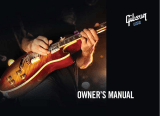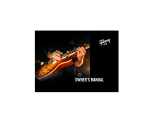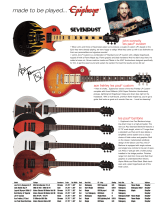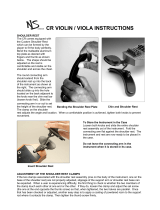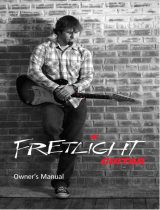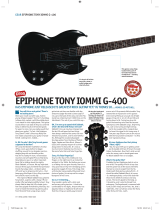Page is loading ...

OWNER’S MANUAL
P U R E
®


© 2003 Gibson Guitar Corp.

To the new Gibson owner:
Congratulations on the purchase of your new Gibson electric guitar – the world’s most famous
electric guitar from the leader of fretted instru m e n t s .
Please take a few minutes to acquaint yourself with the information in this booklet re g a r ding
materials, electronics, “how to,” care, maintenance and more about your guitar.
And then begin enjoying a lifetime of music with your new Gibson.

The Components of an Electric Solidbody Guitar 4
Gibson Innovations 6
The History of Gibson Electric Guitars 8
DESIGN AND CONSTRUCTION
B o d y 1 4
Neck and Headstock 1 4
P i c k u p s 1 5
C o n t ro l s 1 7
B r i d g e 1 9
Ta i l p i e c e 2 1
CARE AND MAINTENANCE
F i n i s h 2 2
Your Guitar on the Road 2 3
Things to Av o i d 2 4
S t r i n g s 2 4
Install your Strings Corre c t l y 2 6
String Gauge 2 7
Brand of Strings 2 7

S t r a p
B u t t o n
S t o p b a r
Ta i l p i e c e
Tu n e - o - m a t i c
B r i d g e
The Components
of the Solidbody
Electric Guitar
Featuring a Les Paul
S t a n d a r d in Heritage
C h e rry Sunburst
12th Fre t
M a r k e r / I n l a y N e c k F re t N u t H e a d s t o c kF i n g e r b o a rd
Tu n i n g
K e y s
M a c h i n e
H e a d s
Truss
R o d
C o v e r
S i n g l e
C u t a w a y
P i c k u p s
B o d yTo n e
C o n t ro l s
Input Jack
T h re e - w a y
Toggle Switch
B i n d i n g
4
Vo l u m e
C o n t ro l s

S t r a p
B u t t o n
S t o p b a r
Ta i l p i e c e
Tu n e - o - m a t i c
B r i d g e
The Components
of the Solidbody
Electric Guitar
Featuring a Flying V
in Wo rn Cherry
12th Fre t
M a r k e r / I n l a y
N e c k F re t N u t H e a d s t o c kF i n g e r b o a rd
Tu n i n g
K e y s
M a c h i n e
H e a d s
Truss
R o d
C o v e r
P i c k u p s
To n e
C o n t ro l
Input Jack Vo l u m e
C o n t ro l s
P i c k g u a rd
B o d y
T h re e - w a y
To g g l e
S w i t c h
5

H e re are just a few of the Gibson innovations that have reshaped the guitar world:
1894 – First archtop guitar
1922 – First ƒ-hole archtop, the L-5
1936 – First professional quality electric guitar, the ES-150
1947 – P-90 single-coil pickup intro d u c e d
1948 – First dual-pickup Gibson, the ES-300
1949 – First three-pickup electric, the ES-5
1949 – First hollowbody electric with pointed cutaway, the ES-175
1952 – First Les Paul guitar
1954 – Les Paul Custom and Les Paul Jr. intro d u c e d
1955 – Les Paul Special intro d u c e d
1957 – First humbucking pickup
1958 – Flying V and Explorer intro d u c e d
6

1958 – First semi-hollowbody guitar, the ES-335
1961 – SG body style introduced in the Les Paul line
1963 – Fire b i rd guitars and Thunderbird basses intro d u c e d
1969 – Les Paul Personal and Professional with low-impedance pickups intro d u c e d
1979 – L.P. Artist with active electronics intro d u c e d
1982 – First solidbody acoustic, the Chet Atkins CE
1983 – Les Paul Studio intro d u c e d
1990 – Les Paul Classic intro d u c e d
1996 – Les Paul Smart Wood intro d u c e d
1998 – Double-Cutaway Les Paul Standard intro d u c e d
2002 – Gibson Digital Electric Guitar intro d u c e d
7

A BRIEF HISTORY OF GIBSON ELECTRIC GUITA R S
G i b s o n ’s legendary acoustic engineer, Lloyd Loar, was experimenting with electric
i n s t r uments in 1924, at the dawn of electronic amplification. However, Gibson’s stru g-
gle to dominate the banjo market took precedence through the 1920s, and it wasn’t
until the mid-1930s that the company once again turned its attention to electric
guitars. In 1935 Gibson’s Walt Fuller designed a pickup that was introduced on the
E-150, an aluminum-body lap steel. Early in 1936, the pickup was put in a midline
a rchtop model and named the ES-150 – ES for Electric Spanish, 150 for the re t a i l
price of $150 for the guitar and amplifier set.
The original ES-150 bar pickup with its hexagonal housing is now known as the
“Charlie Christian” pickup, because it was installed on the ES-150s and ES-250s that
Christian used to establish the new concept of electric jazz guitar.
Gibson made several improvements in pickup design before World War II, although
many players still consider the “Christian” pickup to be the best jazz pickup ever
8

made. Immediately after World War II, Gibson introduced the P-90 single-coil, with six
adjustable polepieces and a black plastic cover, usually with “dog-ear” mounting
extensions. The P-90 is still in production and still sets the industry standard for a sin-
gle-coil pickup.
The first postwar Gibson electrics followed the prewar concept of an electric guitar as
a conventional acoustic archtop with a pickup installed on the top. Gibson added a
second pickup to the ES-300 in 1948 and then became the first company to offer a
t h ree-pickup model with the introduction of the ES-5 in 1949.
Although the advantages of a solidbody guitar had been known to Hawaiian steel gui-
tarists for almost twenty years, it took the persuasive powers of Les Paul, the world’s
most famous guitarist in the early 1950s, to convince Gibson to make a “Spanish
style” solidbody. Gibson designed the new model with a carved top, not only to give it
the look of a traditional archtop – a style invented by Gibson – but also to make it dif-
ficult for other makers to copy. Les, who had been playing a homemade solidbody gui-
t a r, nicknamed The Log, since 1941, specified a maple top cap to increase sustain,
9

coupled with a mahogany back to lighten the weight. Les also specified the famous
“goldtop” finish.
The Les Paul Model debuted in 1952. The bridge and tailpiece were upgraded when
Gibson introduced the patented tune-o-matic bridge in 1954, and the original single-
coil pickups were upgraded with the introduction of Gibson’s patented humbuckers in
1957. Otherwise, the original Les Paul is essentially the same guitar today as it was
when it was intro d u c e d .
In 1954 the growing popularity of the Les Paul Model prompted Gibson to expand the
line. On the high end, the Les Paul Custom sported an ebony finish and low frets for
fast action, and it immediately gained two nicknames: the Black Beauty and the
F retless Wo n d e r. On the more aff o r dable end, the Les Paul Jr. featured a flat “slab”
top and a single pickup, and it became the best-selling Les Paul of the 1950s.
One year after the Les Paul Jr., Gibson off e red a two-pickup version of the slab-body
model called the Les Paul Special. The Special was further distinguished by its yellow
stained “TV” finish.
10

The double-coil humbucking pickup, invented by Gibson engineer Seth Lover, debuted
in 1957 on the Standard and Custom, introducing the sound that would shape ro c k
and roll music in the 1960s.
In 1958, Gibson introduced more important design innovations than in any other
year in the company’s history. Gibson president Ted McCarty combined the look of an
ƒ-hole archtop with the perf o rmance of a solidbody and came up with a completely
new type of guitar – the semi-hollowbody ES-335. McCarty also designed two radical-
ly modern solidbody shapes: the Flying V and Explore r.
The body of the Les Paul Jr. received a pair of rounded horns to become Gibson’s first
double-cutaway solidbody. And the finish color on the Les Paul Model was changed to
C h e rry Sunburst, which let the grain of the maple top show through. The model name
was changed to Les Paul Standard, and the sunburst Standards from 1958-60 would
become some of the most valuable collectibles in the guitar world. All of this happened
in 1958.
11

The new Les Paul Jr. set in motion a complete redesign of the Les Paul line. In 1959
the Special went to the ro u n d e d - h o rn double-cutaway shape and was renamed the SG
Special (SG for Solid Guitar). In 1960, all four models were revamped and given a new
“SG” body shape, featuring a thinner, double-cutaway body with pointed horns. The
Custom, Standard and Jr. retained the Les Paul designation through 1962, after which
they became SG models.
G i b s o n ’s design innovation continued into the 1960s when Ted McCarty hired leg-
e n d a r y automotive designer Ray Deitrich to design a Gibson. The result was the
F i re b i r d series, and the companion Thunderbird bass series of 1963. The Fire b i rd s
“ reversed” conventional designs, with their elongated treble-side horn and tre b l e - s i d e
tuners. They also introduced neck-through-body construction and smaller “mini-hum-
bucking” pickups to the Gibson line.
In response to the rising demand for 1950s-style Les Pauls, the carved-top models
w e re re i n t r oduced in 1968. A new model, the Les Paul Deluxe, featuring mini-hum-
bucking pickups appeared in 1969. The Special was revived in the 1970s and the Jr.
12

re a p p e a red in the 1980s. The Flying V, Explorer and Fire b i r d were also brought back
into regular production, as musical styles began to catch up with these ahead-of-their-
time designs.
While the original four Les Paul models continued as the foundation of the line, Gibson
o ff e r ed new variations, such as the Studio, Classic and Double-Cut Standard, in ord e r
to give musicians all the features they wanted in a Les Paul guitar. In the 50-plus years
of the Les Paul, Gibson has off e r ed more than 100 diff e rent variations. In 2003
Gibson honored Les Paul for his achievements as a perf o rm e r, re c o r ding innovator and
guitar designer by presenting him a special Artist for Eternity award .
As Gibson celebrated the 50th anniversary of the Les Paul in 2002, the company
rocked the guitar world once again by introducing the first digital electric guitar. It re p-
resents the biggest advance in electric guitar design since the instrument was invent-
ed, and more o v e r, it serves notice that Gibson electric guitars will continue to epito-
mize the highest levels of Quality, Prestige and Innovation.
13

DESIGN AND CONSTRUCTION
B o d y. The solidbody guitar was invented to increase sustain, produce a brilliant tone and
eliminate feedback caused by a vibrating top. These qualities are enhanced by wood with
high density, such as maple. Les Paul would have pre f e rred for his model to have had a solid
maple body, but density translates into weight, and a solid maple Les Paul Model would have
been exceedingly heavy. A compromise was reached, with lighter-weight mahogany used for
the main part of the body and maple used for the top cap. Most of the carved-top Les Pauls
have the combination maple/mahogany body, while the “slab” or flat top models have a solid
mahogany body. Flying V’s, Explorers and Fire b i rds have a solid mahogany body.
Neck and Headstock.
Mahogany is a time-proven material for guitar necks, and the necks
of most Gibson USA models are constructed of a single piece of mahogany. The
14

F i re b i r d neck is made of nine-ply mahogany and maple, and it extends completely
t h r ough the body. Fingerboards are of ebony or rosewood.
Neck Specifications.
Width of fingerboard at nut: 1 11/16"
F rets: 22
Scale length: 24 3/4"
P rofile: “Round” ’50s profile or “fast” (slim) ’60s pro f i l e
P i c k u p s .
Humbucking (double-coil): Most Les Pauls have double-coil humbucking
pickups, which were designed to do what their name says: “buck” the hum caused by
f l u o rescent lights, rheostats and other electrical interf e r ence. They accomplish this
with two coils of wire, wound in opposite dire c t i o ns so that they cancel out interf e re n c e .
Also, they produce a powerful sound that is the foundation of rock and roll music.
15

Gibson produces humbuckers in a variety of subtle variations, achieved by the use
of diff e rent magnets and diff e r ent combinations of winding turns. In addition, some
Les Pauls have humbuckers without the metal cover pieces, which results in a hotter
signal. For individual model and pickup specs, please refer to Gibson’s website,
w w w. g i b s o n . c o m .
P-90 (single-coil): Only a few Gibsons – some Les Paul Jr. ’s, Les Paul Specials and
Melody Makers – have single-coil P-90 pickups. Some have the original “dog-eare d ”
covers; those without the “dog ears” are nicknamed “soapbar” because the original
c re a m - c o l o r ed plastic covers on the 1952 Les Paul Model resembled bars of soap.
When the P-90 was introduced in 1946, it was the most powerful pickup of its kind.
And it still is. Among the many examples of the P-90 sound are Carlos Santana’s Les
Paul Special on Santana’s classic re c o rdings, Leslie We s t ’s Les Paul Jr. with the gro u p
Mountain, and The Who’s Pete Townshend with an SG Special on Live at Leeds and at
Woodstock.
16

Pickup adjustments. Although the pickups on each Les Paul are set to Gibson stan-
d a r ds at the factory, they can be adjusted. The height of the pickup can be adjusted
by the two screws found at either end of the pickup, in the mounting ring. Individual
string volume can be adjusted by turning the polepiece screws. Bringing the pickup or
pole screw closer to the strings makes the signal stronger or “hotter.”
C o n t ro l s .
The standard Gibson electronic configuration is two pickups, four knobs and
a pickup selector switch. The four knobs provide individual tone and volume contro l
for each pickup. Models with only three knobs provide individual volume and master
tone control. Single pickup models have only two knobs – for volume and tone contro l
– and no pickup selector.
Volume contro l s : The two knobs closest to the fingerboard control volume. The volume
knob nearest the bridge controls the “front” or neck pickup; the knob nearest the edge
of the guitar controls the “back” or bridge pickup.
17

Tone contro l s : The knob or knobs farthest away from the fingerboard control tone. The
tone knob nearest the bridge controls the “front” or neck pickup; the knob nearest the
edge of the guitar controls the “back” or bridge pickup.
The tone controls are the “treble roll off” or “cut” variety. The tonal quality of the
i n s t r ument is darkened by the reduction of treble rather than the addition of bass. The
tone control turned all the way counterclockwise results in maximum reduction of tre-
ble and produces the “darkest” sound. The tone control turned clockwise to its maxi-
mum position allows the pickup’s full harmonic frequencies to pass through, pro d u c-
ing the guitar’s brightest sound.
Pickup selector switch: The selector switch has three positions. The position toward
the neck selects only the “front” or neck pickup. The position toward the bridge of the
guitar selects only the “back” or bridge pickup. The middle position engages both pick-
ups. The tone and volume controls will only be active when the corresponding pickup
is selected. On models with three pickups, the selector switch activates the front pick-
18
/
